Can stocked Bloater (Coregonus hoyi) survival be increased with environmental conditioning?
Contributing Authors
Dimitry Gorsky (USFWS, dimitry_girsky@fws.gov), Matthew Altenritter (SUNY-Brockport), Brian Weidel (USGS), Michael Chislock (SUNY-Brockport), Steve Davis (USFWS), Gregg Mackey (USGS), John Sweka (USFWS)
Project Description
Bloater (Coregonus hoyi) were historically an important component of the Lake Ontario fish community but the species was likely extirpated by the 1970’s. A binational restoration has stocked over one million Bloater into Lake Ontario since 2012, however, low post-stocking survival has challenged the rehabilitation. Studies and meta analyses have suggested conservation biology principles can be relatively easily implemented to improve stocked fish survival by creating individuals that more closely resemble and perform similarly to their wild counterparts. Conditioning fishes prior to release is a widely employed technique and has improved survival across a variety of fishes. For instance, in Lake Ontario, environmental conditioning, or “soft-release” has increased Chinook Salmon smolt to harvest survival 1.7 to 2.3 times over direct stocked or “hard released” fish. Such approaches could prove useful for Great Lakes Coregonus restorations where post-release survival may be an impediment, but the feasibility and efficacy of these approaches has not been tested. Herein we propose two pilot studies to test the efficacy and feasibility of conditioning to improve post-stocking survival.
An on-going project, funded by the Great Lakes Fish and Wildlife Restoration Act, is currently using a dense (N=120) acoustic receiver array (Fig 1) to evaluate how Bloater post-stocking survival varies across three release depths (5, 55, 100m). This project plans to release non-conditioned Bloater in spring 2023, providing a unique and efficient opportunity to test if environmental conditioning can increase the survival of stocked Bloater. Fish become familiar with new environments within ~ three days and conditioning over similar short periods has improved survival over non-conditioned fish. We propose to test whether conditioning influences released Bloater behavior or survival. We would acoustically tag 40 yearling Bloater, conditioning them in Lake Ontario at the release site for one week, then release them at the same time as the already planned release of acoustic tagged, non-conditioned Bloater. We expect survival to be greater and suspect behavior may also differ. Our research group has been experimenting with in situ enclosures at this site for studying stocked Bloater. In May 2022, video equipped cages illustrated that Bloater survived short term exposure (15 minutes) to increased pressure at depths of 100 meters (Fig 2).
Culture methods for Great Lakes Bloater have rapidly improved, however techniques have focused on traditional bloodstock development and hatchery-based rearing to meet targets of numbers stocked. Focusing stocking on maximizing numbers as opposed to the quality of the individuals stocked has been often challenged, and may contribute to why many stocking efforts result in poor survival and efficacy. Interestingly, neither of the available North American Coregonus sp. culture manuals mention soft release techniques. In contrast, more developed European coregonine culture frequently uses in situ rearing, including illuminated cages, to grow and condition juveniles to feed on ambient zooplankton and these methods support commercially fished populations. Studies in Pickerel Lake, MI, suggest juvenile in situ rearing is possible as those researchers observed Cisco (Coregonus artedi) and Lake Whitefish (Coregonus clupeaformis) held in pens, grew in both length and mass with concomitant increases in consumption of zooplankton from the ambient environment. We would evaluate the logistics and efficacy of net pen rearing and conditioning for Age-0 Bloater in Irondequoit Bay, New York. This large deep embayment is readily accessible, provides suitable epilimnetic temperatures for juvenile Bloater, and protection from main lake winds and currents. We view this project as a first step in evaluating how alternative approaches could support restoration by increasing survival of stocked fishes.
